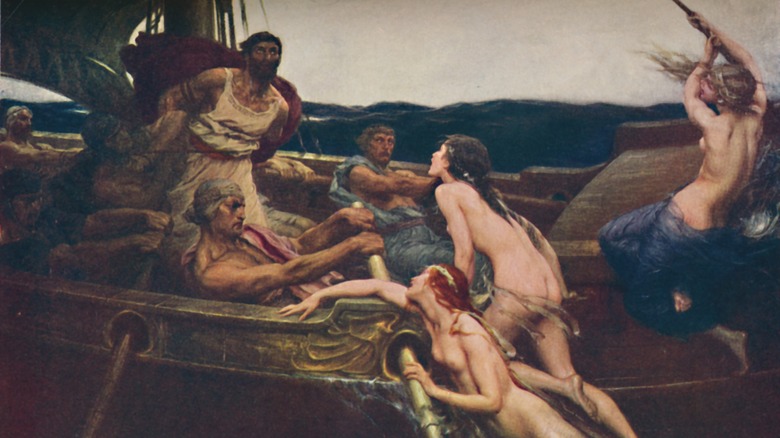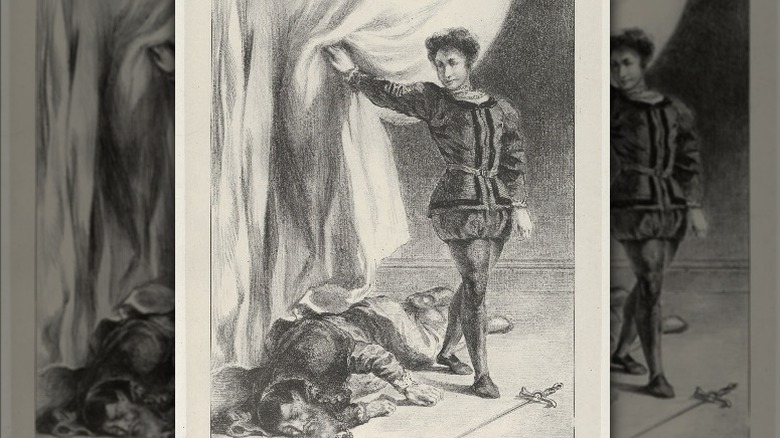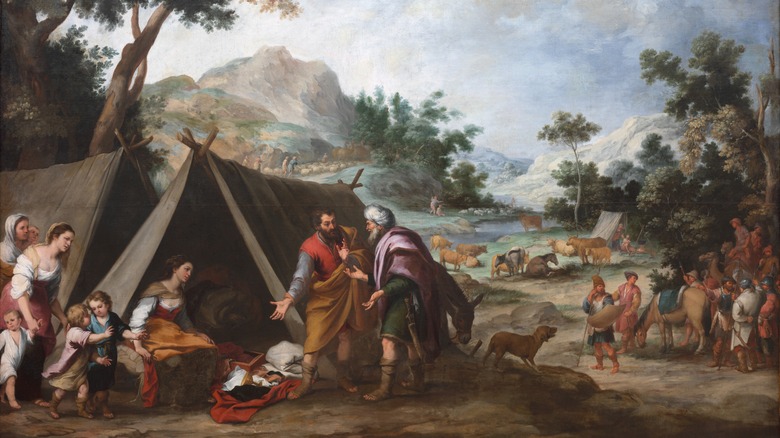The Legend Of Amleth Explained
American filmmaker Robert Eggers, of "The Witch" and "The Lighthouse" fame, is back at it with a brutal, atmospheric take on the Scandinavian legend that inspired Shakespeare's "Hamlet" — "The Northman" (via Vogue). Eggers collaborated on the script with Sjón, an award-winning Icelandic poet, lyricist, and novelist. And the movie embodies menacing, moody horror, enhanced by sweeping views of Iceland's unwelcoming, hostile, and isolated environment.
The trailer reveals a star-studded cast, including Nicole Kidman, Ethan Hawke, Alexander Skarsgård, Anya Taylor-Joy, and Iceland's iconic pop star and performance artist, Björk. Bulking up for his turn as a Viking, Skarsgård's impressive girth makes the muscle he gained for "Tarzan" look downright puny. And his blood-smattered torso speaks of revenge. Besides the incredible cast, Eggers' mastery of horror is in fair form as he plumbs the depths of Viking lore and Scandinavia's harshest climates to create an eerie setting where supernatural elements vie with humans for dominance.
The official trailer offers glimpses of the brutal murder that sends Skarsgård's character, Amleth, on a mission for revenge. But it's the relentless chant of the boy to avenge his father, rescue his mother, and kill his uncle that drives the trailer's momentum. This mantra hurtles Amleth towards an undeniable and inescapable fate. Although "The Northman" appears to be worlds away from its Elizabethan counterpart, "Hamlet," it relies on the same basic storyline. Here's what there is to know about "The Legend of Amleth" as inspiration for "The Northman."
Who was Amleth?
From the ninth through the 11th centuries, marauding seafarers reshaped Europe and much of the Old World (via Britannica). Pagan warriors hailing from modern-day Norway, Sweden, and Denmark, they lived as independent farmers domestically. But when motivated by overseas treasure, the relative helplessness of their victims, and overpopulation, they became a brutal and far-ranging killing force.
Relying on lightweight, shallow longboats, they handily navigated the roughest seas and could sail up rivers, waging warfare well inland. They indulged in hard-hitting, fast-paced coastal attacks where sheer brutality provided shock and awe. They mercilessly killed, plundered, and burned everything from isolated monasteries to thriving urban cities, giving no quarter. Thus, they earned the title "víkingr," meaning pirates in the proto-Scandinavian languages.
"The Legend of Amleth," a Norse folktale recorded in Latin around the 13th century, provides glimpses into this world, per British Library. First recorded in the Dark Ages in the "Gesta Danorum" ("The Deeds of the Danes"), it marked part of a more extensive collection by Saxo Grammaticus, a Danish historian. You'll find Amleth's story in Books III and IV, per the Medievalists. How Shakespeare came across the story remains unclear (via Western Michigan University). But François de Belleforest published a version in 1571's "Histoires Tragiques" ("Tragic Histories"), which may have provided the source material. Whatever the case, the original story unapologetically glorifies Nordic-style vengeance and bloodletting.
Sibling rivalry sparks the plot
Sibling rivalries are as old as literature, whether Cain and Abel (per Table Talk) or the brothers Karamazov (via Crime Reads). A universal theme that extends well beyond the Bible or Russian literature, sibling rivalry launches the action of "The Legend of Amleth" and its creative descendants "Hamlet" and "The Northman." The vicious betrayal occurs between Aurvandil War-Raven and his brother Fjölnir (soon to be Fjölnir the Brotherless).
According to Saxo Grammaticus' "Gesta Danoram," the rivalry between the brothers heats up when Denmark's King Rørik appoints them as co-rulers of Jutland (portions of modern-day Denmark and Germany, per Britannica). Fjölnir's jealousy explodes after Aurvandil kills the king of Norway and marries Gudrún, Rørik of Denmark's daughter. The marriage produces a son and heir, Amleth.
Paying no heed to familial ties, Fjölnir viciously slaughters his brother, stealing his kingdom and Queen Gudrún in the bargain. Or, as Saxo Grammaticus describes it, "Then, he took the wife of the brother he had butchered." Amleth is collateral damage. In "The Legend of Amleth," the protagonist avoids his uncle's wrath by feigning madness, much like Hamlet centuries later. As for "The Northman," synopses of the film tell us he escapes his uncle's grasp, consumed by the goal of eventually returning to kill Fjölnir, save his mother, and retake the throne (via Vogue).
Amleth hid behind mental instability
The murder of his father and marriage of his mother, Queen Gudrún, to Fjölnir the Brotherless puts Amleth in a precarious position. In the trailer to 2022's "The Northman," Amleth witnesses his father's cowardly murder at the hands of his uncle. This traumatic event sets the action of the story into motion. It also motivates the protagonist to flee his homeland commencing the hero's journey that will eventually bring him back for revenge.
But Saxo Grammaticus' version proves more ambiguous about what Amleth witnessed. On the one hand, there's no mention of Amleth present at King Aurvandil's murder. On the other hand, at the end of the summary of Fjölnir's repugnant behavior, Grammaticus writes, "Amleth beheld all this, but feared lest too shrewd a behaviour might make his uncle suspect him." Whether "all this" refers to Aurvandil's murder or the events after is left to the reader's imagination. Instead of fleeing, Amleth puts on the act of a lifetime, playing the part of a powerless crazy man to assuage his uncle's suspicions (via the Medievalists).
Grammaticus describes Amleth as listless and useless, wearing dirty clothes and refusing to bathe. His outward appearance of foolishness contrasts wildly with his slow inner burn for revenge against his father's murderer and mother's betrayer. Grammaticus plays on this tension throughout the text, providing hints to the reader that Amleth is far from what he seems, even as he babbles incoherently to those around him.
He spoke truth while playing the part of a fool
The British Library reports Amleth translates as "stupid," which further fuels the case that he's no threat to Fjölnir. Or, as Saxo Grammaticus puts it, "In a word, you would not have thought him a man at all, but some absurd abortion due to a mad fit of destiny." Yet, beneath the surface, there's another tale to tell, and Grammaticus exploits the tension between what looks real and is real to great effect.
Although Amleth acts imbecilic and harmless, he also feels compelled to tell the truth, leading to unnerving exchanges. To navigate the fine line between tomfoolery and detection, he speaks in ambiguities that prove unsettling to court members, including his uncle. For example, after Grammaticus' description of Amleth quoted above, we get an episode of honesty that should get Amleth killed.
The author relates how Amleth spends his days fashioning small weapons over the fire, which he tells people he plans to use to avenge his father. Although his slimy face and filthy clothes cause them to laugh in response, assuming him a venomless fool, some wonder if he's crazy like a fox. As Grammaticus notes, the craftsmanship of the weapons attests to greater intellectual ability than what Amleth lets on in day-to-day conversations. Nevertheless, by acting idiotic, Amleth renders himself even less fit than a murderer for the throne, providing his uncle false assurances, per the Medievalists.
The Legend of Amleth explores societal taboos
Like the universal theme of sibling rivalry, "The Legend of Amleth" also explores societal taboos that crop up often in literature. Although Sigmund Freud never gave us an analysis of Saxo Grammaticus' original tale, he did delve into the matter regarding William Shakespeare's "Hamlet" in his essay from 1900 entitled "On Repression in Hamlet."
The famed psychoanalyst argues that Shakespeare's protagonist wrestles with the same dark impulses as Sophocles' hero in "Oedipus Rex." But instead of literally killing his father and marrying his mother, as poor Oedipus does, Hamlet's conflict proves more cerebral than physical. Since "Hamlet" comes from the ancient cloth of "The Legend of Amleth," one might assume the Oedipus complex theory applies to him, too.
But Saxo Grammaticus makes it clear such is not the case. The original text emphasizes which societal taboos have been broken and who has done the breaking. They include fratricide, which occurred at the hands of Fjölnir when he murdered Aurvandil War-Raven, and sleeping with his sister-in-law, Queen Gudrún. Grammaticus sets Amleth up as the only individual who can right the wrongs that have been committed, restoring balance to the kingdom once more. As a result, there's no wrestling with hesitation as we see in "Hamlet." Instead, the author makes it clear that Amleth will act as soon as an opportunity presents itself.
The femme fatale bucks trends and saves the hero
Despite his attempts to remain the buffoon at court, Amleth's irrepressible honesty eventually incites his uncle's suspicions, according to British Library. To bait Amleth into revealing his true intentions, Fjölnir sends Amleth's nameless foster-sister (think an early version of Ophelia) to seduce him, per the Medievalists.
The notion of a beautiful woman who tempts a man to his destruction is one of the oldest in literature. It goes back to the myth of Adam's first wife Lilith, the goddess Ishtar in "The Epic of Gilgamesh," and the Sirens that threaten Odysseus' ship in "The Odyssey" (via Bustle). But we're in for a twist when it comes to "The Legend of Amleth." Although Saxo Grammaticus has Amleth cunningly find a place to sleep with the seductress far from prying eyes, she turns out to be a poor choice as a femme fatale. Grammaticus tells us they've known one another since early childhood, and their bonds of intimacy extend to fierce loyalty.
As a result, the alleged seductress of Amleth acts as his protector. Readers wonder why Fjölnir would choose someone so close to Amleth to seduce him. But the answer appears to lie in Fjölnir's attitude towards his nephew. He takes very little notice of Amleth while completely underestimating him. In other words, the king's grave error belies his great disdain for Amleth.
The women in Amleth's life have no voices
One of the most significant differences between "The Legend of Amleth" and Shakespeare's "Hamlet" is the role of women. For example, "The Legend of Amleth's" proto-Ophelia and femme fatale character remains nameless. And this despite the fact she plays an integral role in saving the hero from Fjölnir's trap!
As for Queen Gudrún, the men in her life make decisions for her and speak on her behalf. Fjölnir uses her as a scapegoat for his crimes. He claims that Queen Gudrún faced wanton cruelty at the hands of his brother and her husband, Aurvandil. But Fjölnir couldn't bear to watch it any longer. So, he did the only thing any "reasonable" person would do — kill his brother and marry his sister-in-law. While it's a fascinating angle that could add considerable emotional complexity to the original Nordic tale, Queen Gudrún never weighs in.
The Queen also seems ill-equipped to protect her vulnerable son when he needs it most. Even though she's the daughter of King Rørik and one of the few individuals in the story with actual royal blood, she lacks self-determination. Amleth will take Gudrún's silence for guilt, something he addresses later while confronting her. But even during his argument with his mother, the conversation proves entirely one-sided, with him doing all the talking.
Amleth makes his mother an honest woman
Still suspicioning Amleth, Fjölnir sends a spy to eavesdrop on the young man while he speaks with his mother, according to British Library. In Shakespeare's play, this marks one of the most famous scenes as Hamlet denounces his mother, Queen Gertrude, for her crimes, per Internet Shakespeare. Gertrude has plenty to say in her defense, making for a dramatic climax. One that leads to her crying out in fear, revealing the spy behind the curtain (via YouTube).
But in Saxo Grammaticus' text, we only get Amleth's dialogue as he castigates his mother for "wantoning like a harlot ... embracing with incestuous bosom thy husband's slayer, and wheedling with filthy lures of blandishment him who had slain the father of thy son." That's some hefty language to wield at his mother, and you'd think she'd have a retort or two. But we get radio silence.
Grammaticus notes simply that Amleth's words corrected his mother's behavior, returning her to the path of virtue. The lack of dialogue leaves plenty of room for interpretation. Similarly, Nicole Kidman's portrayal of Queen Gudrún in the trailer for "The Northman" appears frigid and emotionless. There's no flash of joy on her face when Aurvandil returns, and the king heartily greets his son while ignoring his wife. Something's rotten in the state of Jutland, and it might just be their marriage.
Spies don't fare well in The Legend of Amleth
During the tense conversation with his mother, Queen Gudrún, Amleth realizes somebody's eavesdropping on their conversation, per British Library. Unlike Shakespeare's man behind the tapestry, the spy has staked out in a dark corner of the Queen's room beneath a pile of straw, as reported by Internet Shakespeare. (How far interior decorating has come since the Dark Ages!)
Realizing the spy will out him as not only sane but plotting to kill his uncle, Amleth acts quickly and decisively. In a rage, he kills the spy, slices up and cooks his body in boiling water, and throws the pieces into the sewer. Pigs feast on what's left. Spies are clearly considered the lowest of the low in this world, the equivalent of swine's food.
Later, Fjölnir will question his nephew about the whereabouts of the missing spy. Amleth darkly replies that the man has fallen to his death (and the greedy mouths of pigs) through the outhouse (via "The Legend of Amleth"). Again, this passage shows us that Amleth doesn't like to stray far from the truth, even when it stands to implicate him in grimmer dealings. But due to his previous reputation as an imbecile and the nonsensical nature of the story he weaves, Saxo Grammaticus assures us that no one takes the young man seriously.
The trickster gets tricked
Fjölnir finds himself stuck between a rock and a hard spot at this point in the story, per "The Legend of Amleth." Although highly suspicious of his nephew, he can't act. Saxo Grammaticus explains that Fjölnir fears the reprisals of Queen Gudrún and her father, King Rørik. After all, Amleth is their heir. So, he chooses cowardly cunning to take out his rival.
He has two escorts accompany Amleth to England with a letter ordering his execution upon arrival, per British Library. But Amleth outsmarts his wily uncle, rewriting portions of the letter to have his escorts killed. Then, he marries the daughter of the English king, further securing his noble claims. The master trickster, Fjölnir, gets outmaneuvered by a cleverer foe. Grammaticus uses this motif to emphasize the superior traits of Amleth, pointing to his rightful place on the throne (via Western Michigan University).
To borrow from "Beauty and the Beast," the trickster tricked theme is a tale as old as time. Similar motifs pervade other examples of ancient and medieval literature. They include the deceptions that go back and forth between Jacob and his father-in-law Laban in the Bible, per Ligonier. And there's also the trickster hero Odysseus who experiences plenty of retribution through trickery and deception for deceiving Poseidon's son, Polyphemus, and incurring the god's wrath (via Jenny Clay's "The Wrath of Athena: Gods and Men in the Odyssey"). Grammaticus employs this satisfying literary device well.
The revenge justify the means
Revenge pervades "The Legend of Amleth," and it remains one of the master plots of classic literature. But unlike Shakespeare's "Hamlet," where the playwright spends time ruminating over the devastating impacts of revenge-seeking on the main characters, Amleth is shown as victorious and justified. End of story. This reflects the Viking ethos of the day.
The Medievalists assert that revenge-seeking remained a vital aspect of maintaining honor in Dark Ages Northern Europe. And Amleth is ultimately a Viking hero. Vikings saw revenge and violence as unquestioned necessities. Under the right circumstances, they were indispensable means of righting wrongs and restoring societal order. So, you don't find Amleth wandering through cemeteries embroiled in deep soliloquies. He's part of a culture with structured means for dealing with transgressions, which makes self-reflection on the negative impacts of revenge-seeking unthinkable.
After killing his uncle and his courtiers, Saxo Grammaticus sings Amleth's immortal praises. The author notes, "By skilful defence of himself, and strenuous revenge for his parent, he has left it doubtful whether we are to think more of his wit or his bravery." This celebration of Amleth's violent overthrow of Fjölnir leaves many narrative threads untied, including what happens to his mother, Queen Gudrún. But such considerations appear to pale in comparison to lauding the regeneration of Viking societal order through violence.











